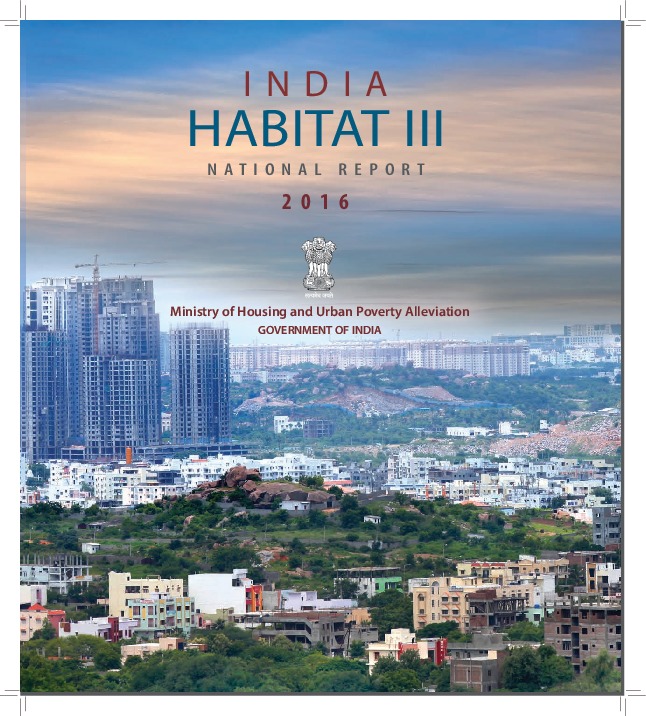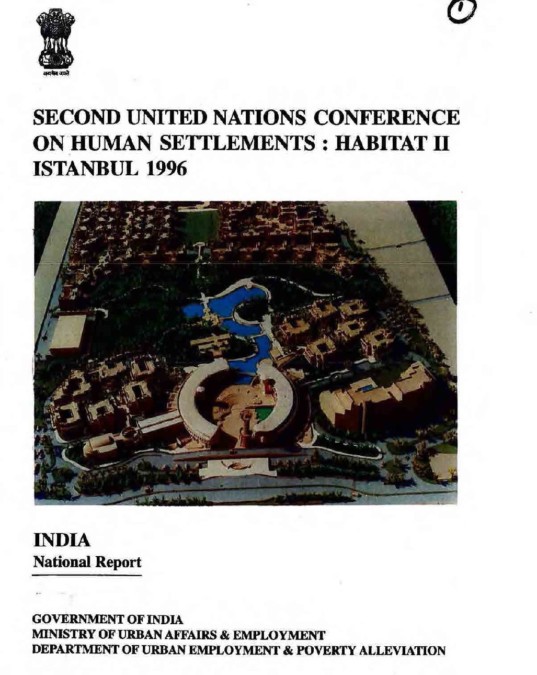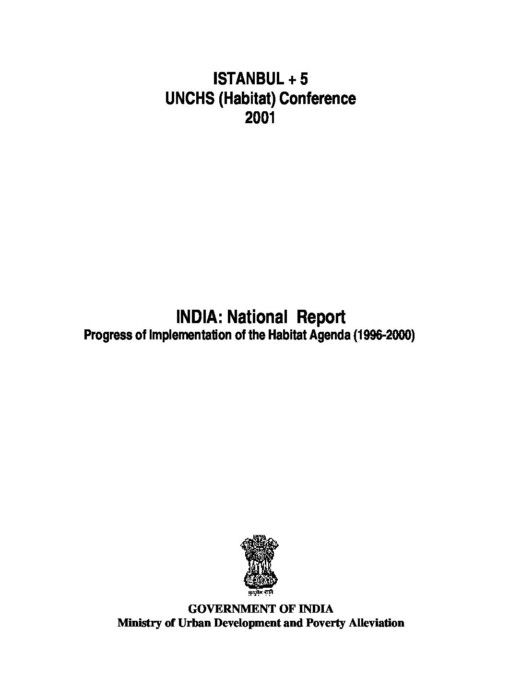
India
Urban indicators:
| Value | Year | ||
| Surface area (sq km) | 3287263 | 2014 | |
| Population (proj., 000) | 1326802 | 2016 | |
| Pop. density (per sq km) | 446.3 | 2016 | |
| Capital city | New Delhi | 2015 | |
| Capital city pop. (000) | 250 | 2015 | 2011. |
| Population growth rate (average annual %) | 1.3 | 2010-2015 | |
| Urban population growth rate (average annual %) | 2.4 | 2010-2015 | |
| CO2 emission estimates (000 tons/tons per capita) | 2034752/1.6 | 2013 | |
| Population using improved drinking water sources (urban/rural, %) | 97.1/92.7 | 2015 | |
| Population using improved sanitation facilities (urban/rural, %) | 62.6/28.5 | 2015 |
| 1995 | 2005 | 2014/2015 | |
| Urban population ('000) | 254,314 | 329,517 | 419,939 |
| Level of urbanization (%) | 26.6 | 29.2 | 32.7 |
| Proportion of urban population living in slum areas (%) | 48.2 | 34.8 | 24.0 |
| Urban Slum Population ('000) | 122,231 | 112,913 | 98,449 |
| Value | Year | |
| Urban Gini Coefficient | 0.37 | 2004c |
| Urban poverty headcount ratio based on national poverty lines | 13.7% | 2011 |
National Report:
National Report Executive Summary:
Prepared in response to resolution 24/14 of the UN-Habitat Governing Council, the India National Report presents an assessment of the country’s urban sector and its contemporary and emerging challenges and opportunities, and gives a brief account of the urban initiatives and a prospective vision for the new urban agenda.
1. Urbanization is an important emerging reality in India
Urbanization is one of the important realities of recent decades in India. Its urban system consists of 7933 cities and towns of different population sizes, and a population of 377.16 million (Census 2011), which is the second largest in the world. The urban system has registered an extraordinary expansion in its base over the 2001–11 decade, and this trend is expected to continue. An estimated 180 million rural people live next to India’s 70 largest urban centres, a number that will increase to about 210 million by 2030 (McKinsey Global Institute, 2010).
2. Growth in the numbers and population of metropolitan cities and census towns represent the most recent trend in India’s urbanization
In recent decades, the pattern of India’s urbanization has undergone an important shift which is characterised by (i) increasing numbers and rising population share of metropolitan cities, and (ii) an unprecedented increase in the numbers and population of census towns whose share in urban population has risen to 14.5 per cent (Census 2011) from 7.6 per cent in 2001. Metropolitan cities continue to be a collection of municipalities and other settlements, drawing powers directly from the respective statutes and presenting a monumental challenge of “who governs”. Census towns, on the other hand, present problems of sprawl and unregulated development, fuelling fears of weakening of agglomeration economies.
3. India’s urbanization is poised to accelerate in the coming decades
In 2011, India entered into a different demographic trajectory with the net increment to urban population exceeding the net increment to rural population. The United Nations (2014) estimates that much of the population increase in India between 2015 and 2030 will take place in urban areas during which it will add 164 million people to its urban base. The scale of the projected urban population increase is extraordinary, offering both an opportunity as well as a challenge for it to mobilize its resources and capacity to manage the transition.
4. Urbanization has made significant contributions to India’s economic growth and poverty reduction
Urbanization is central to India’s economy, contributing close to 60 per cent to its Gross Domestic Product (GDP). Recent studies attest to the increasing linkages between urbanization and per capita GDP; however, these are low compared to other large Asian economies. There exist large, untapped economies of scale, which require effective interventions in the spheres of urban and spatial planning, urban land markets, and governance. Urban poverty levels have declined substantially, from 25.7 per cent in 2004–05 to about 13.7 per cent in 2011–12.
5. Managing and facilitating the process of urbanization is essential for India’s structural transformation
India recognizes that managing the process of urbanization is a necessary condition for India’s structural transformation. In comparative terms, India is at a low level of urbanization (31.16 per cent in 2011). But much of the increase in urban population will take place in the coming decades. Urbanization will need to be viewed as a shared responsibility between governments at various levels and between public and private sectors, and civil society.
6. Aligning urban land markets to the forces of India’s urbanization continues to be a challenge
Urban lands in India, constituting 3.1 per cent of the country’s land area, present a complex situation where high urban densities co-exist with sub-optimal utilization. Although the overall supply of urban lands has risen over the 2001–11 period, the general perception that supply lags behind the demand persists. Supply and usage of urban lands are regulated cross the globe, India is no exception. However, the processes of land acquisition for urban use are cumbersome and constrained by factors such as the purpose underlying land acquisition, the amount of compensation, and the likes. Several initiatives have been taken in recent years to lay down fresh rules for land acquisition (The Land Acquisition, Resettlement and Rehabilitation Act, 2013), and to increase land supplies with innovative practices such as land pooling, land readjustment, negotiated land purchases, and transit-oriented development. Other important initiatives in this sphere relate to introducing online procedures for land registration, reduction of stamp duties and repeal of the Urban Land (Ceilings and Regulation) Act, 1976.
7. Strengthening public transport forms the core of the National Urban Transport Policy
Urban transport infrastructure and services are grossly inadequate, both in quantity and quality. Private motor vehicles have multiplied over a hundred times in recent decades, while the road network and capacity stand severely stressed. Public bus services, which are state-owned public entities are limited to large cities. The use of modes such as walking and bicycling, and other para-transport modes is on the decline—the overall result being increasing road congestion, falling road speed, increasing air pollution, and reduced road safety. The National Urban Transport Policy (2006) focuses on planning for people rather than vehicles, by providing sustainable mobility and accessibility to places of work, education, services and recreation at affordable costs. It has involved internalizing urban transport as a key variable in urban planning exercises. It calls for putting in place intelligent transport systems for traffic management, and establishing institutional mechanisms and capacity building for better planning and management of transport systems.
8. Urban air and water pollution and emission levels are an increasing concern and are engaging dedicated attention
That urbanization is not neutral in its impact on environment and climate change is beginning to enter India’s development strategy. The key environmental concerns that confront India are: (i) to strike a balance where the benefits of urbanization (agglomeration economies) are maximized without compromising the environmental benchmarks, and (ii) to address environmental challenges triggered by extreme weather conditions, requiring substantial adjustments to urban planning, land-use management and infrastructure strategies and norms. Studies on cities and their environment have underlined the economic cost that the country bears on the account of poor air and water quality. Several steps have been taken to address environment-related issues, which in the main include a National Mission on Sustainable Habitat. The main objectives of the Mission are promotion of energy efficiency as a core component in urban planning, enforcement of fuel efficiencies, management of urban waste, and promotion of public transport. Other linked incentives include reduction of subsidies on unclean fuels, promotion of transit-oriented development, and development of compact cities and mixed land-use Master Plans. India, being a signatory to the Paris accord, stands committed to meeting its stated goals and objectives.
9. Housing is a key sector with significant economic and social impacts for the Indian economy
The construction sector, of which housing is a major component, accounts for 8.2 per cent of the GDP, 11.39 per cent of the total output, and 11.5 per cent of employment. For reasons of its forward and backward linkages, the governments at the central and state levels have been long engaged in addressing the challenges of adequate and affordable housing in cities and towns. These have involved initiatives for direct production of housing for the urban poor, provision of credit and interest subsidies to the poorer sections of urban population, promoting alternative construction materials and technologies, and involvement of stakeholders in the housing activity. The recent census data indicates that absolute housing shortages in cities and towns have declined from 1.63 million units in 2001 to 0.39 million in 2011. At the same time, however, the relative shortages, measured in terms of congestion and obsolescence, are high at 18.8 million units (2012). A National Housing Policy (NHP) was put in place in 1988. It was revised in 1994 with provision for Foreign Direct Investment in the real estate sector. This policy was further modified as the National Urban Housing and Habitat Policy (NUHHP, 2007), which seeks to earmark lands for economically weaker and low-income households in the new housing projects. Building codes and byelaws have been modified and now consist of provisions for green buildings, natural-disaster resilience, and inclusive design for the elderly and the physically challenged. More recently, a mission on Housing For All ( Pradhan Mantri Awas Yojana) has been launched with the aim of constructing 20 million housing units for the urban poor and slum households.
10. Infrastructure deficits are severe across cities and towns, and have dented urban quality of life and local economic development
The importance of urban infrastructure is commonly highlighted in terms of its centrality to productivity and quality of life, and on grounds of the close association between infrastructure flows and GDP. Despite this, infrastructure deficits and deprivation in Indian cities persist. Studies have noted structural dysfunctionalities, like non-revenue water, low-level of metering and below-cost pricing, as barriers to both public and private investment. The government has been concerned with these deficits and has attempted to address them under the JnNURM, and has mounted a concerted effort via its recently launched missions, which include Smart Cities Mission, AMRUT, and Clean India Mission. Several good practices involving the private sector are cited as examples for replication.
11. Governance holds the key to well–managed cities and towns. Urban development is being taken as a shared responsibility of the different tiers of government and of the public and private sectors
Urban development is a subject of states under the India’s federal structure. State governments define state-specific urban development policies, establish institutions including local governments for advancing the urban policy agenda, and design and implement urban development programmes and projects. The role of the central government is to define an overall approach to urban development, compatible with macroeconomic parameters. As cities have acquired increasing importance in the national economy, the central government has, in partnership with the state and local governments, introduced a slew of initiatives to enable the participation of local governments in nation-building agenda, making urban development a shared responsibility. Urban local governments are central to the implementation of urban development agenda. The purpose underlying the constitutional amendment (1992), which is built on the principle of subsidiarity, is to empower urban local governments across the political, functional, and financial spectrum; the progress in this direction is being accelerated by redefining the relationships between urban local governments and other institutions and stakeholders.
12. Financing urban development is one of the most demanding challenges that India faces in managing urbanization
The two recent studies (McKinsey Global Institute in 2010 and High-Powered Expert Committee in 2011) place the investment requirements for urban infrastructure between U.S.$810 million and U.S. $1.2 trillion for a period of 20 years. Recent decades have been marked by a large number of initiatives aimed at the structural, functional and financial components of India’s municipal system. A common underlying thrust of these initiatives is to strengthen municipal finance and governance by modifying what are deemed to be the problematic elements of the system and to align them with the contemporary changes. These initiatives are accompanied by an array of institutions and proposals for modifications in the existing statutory and regulatory structures to bring about a change in the finances and functions of urban local governments. These include setting up of State Finance Commissions (SFCs), District Planning Committees (DPCs), Metropolitan Planning Committees (MPCs), and Property Tax Boards, and an array of new initiatives which include Public-Private Partnership (PPP) in the delivery of services, capital market financing, debt financing, National Investment and Infrastructure Fund (NIIF), and land-based instruments for financing urban infrastructure.
13. Addressing the challenges of urbanization and tapping urban opportunities lies at the core of the recent urban sector initiatives
In India, the post 1990 period has witnessed an explicit recognition of the role of urbanization and cities in the country’s socio-economic transformation. Successive five-year plans have focussed on efforts to enhance the role of urbanization in the development process.
14. Smart Cities Mission, AMRUT, HRIDAY,Housing for All, and Clean India Mission, and development of RURBAN clusters provide a fresh impetus to the urban sector
Over the past two years, the urban sector in India has received a major boost via the launch of new initiatives (Box 1), which aim at enhancing the quality of life and providing a clean environment, creating infrastructure, addressing the housing requirements of the poor and slum households, promoting India’s heritage, creating awareness about sanitation, and forging and strengthening rural-urban linkages and inter-dependencies.
15. India recognizes the place of cities in the country’s transformation and notes its commitment to implementing the Sustainable Development Goal 11 and the New Urban Agenda
India is at a crucial stage in its urban transition, having crossed the threshold of 30 per cent level of urbanization, which is the stage from where urban population growth begins to accelerate. It plans to reinforce the urbanization process with an agenda that comprises the following levers that would make cities work towards greater productivity, inclusion, sustainability, and rural-urban linkages. The levers are:
• Putting in place integrated and coherent urban policies consistent with the principle of cooperative federalism;
• Harmonizing agglomeration economies with focus on the promotion of compact and cluster urban development within a regional, rural-urban framework;
• Harnessing rural-urban continuum;
• Promoting inclusive urban development, inter alia, comprising universalization of basic services, social cohesion, and strategies for reducing working poverty;
• Recognize and actively promote the centrality of sustainability in urban policy;
• Empower municipalities and other local-level institutions;
• Strengthen housing-finance systems;
• Enhance access to social justice and gender equity; and
• Development of a robust urban information system.
India stands at a juncture in history where ambiguities about what urbanization can do to transform the country’s economy have been overcome and an environment exists where a bolder push to use urbanization for country’s socio-economy is on the horizon. Globally, the UN-Habitat is striving to arrive at a consensus on an urban agenda that would commit countries to sustainable urbanization “which is now more critical than ever as populations, social interactions, economic activities, and environmental impacts are increasingly concentrated in cities”. India’s new urban agenda has been envisioned in this context.
Statements by India:
-
PrepCom3
-
Habitat III Plenaries
-
Intersessionals: Informal Intergovernmental Meetings (May 2016)
Statements by other countries on behalf of G77 and China:
-
Habitat III Plenaries
-
Intersessionals: Informal Intergovernmental Meetings (May 2016)
- Statement - 18 May (by Thailand) - English Made by Thailand on Behalf of G77 and China
- Statement - 18 May (by Jamaica) - English Made by Jamaica on Behalf of G77 and China
- Statement - 19 May (by Jamaica) - English Made by Jamaica on Behalf of G77 and China
- Statement - 19 May (by Kenya) - English Made by Kenya on Behalf of G77 and China
- Statement - 20 May (by Jamaica) - English Made by Jamaica on Behalf of G77 and China
- Statement - 20 May (by Thailand) - English Made by Thailand on Behalf of G77 and China



